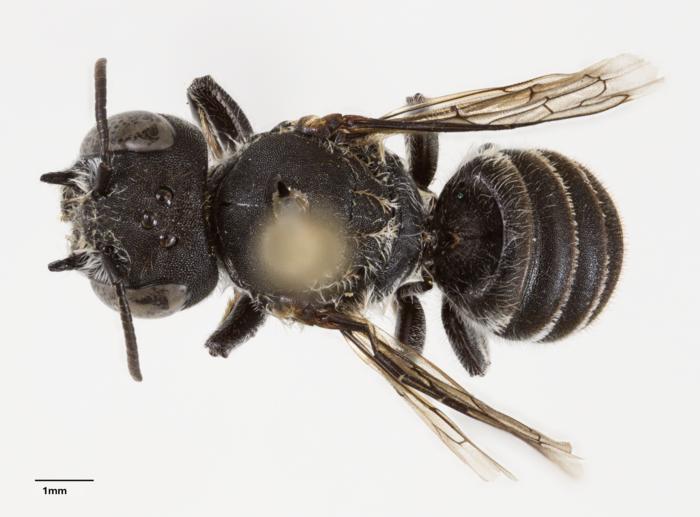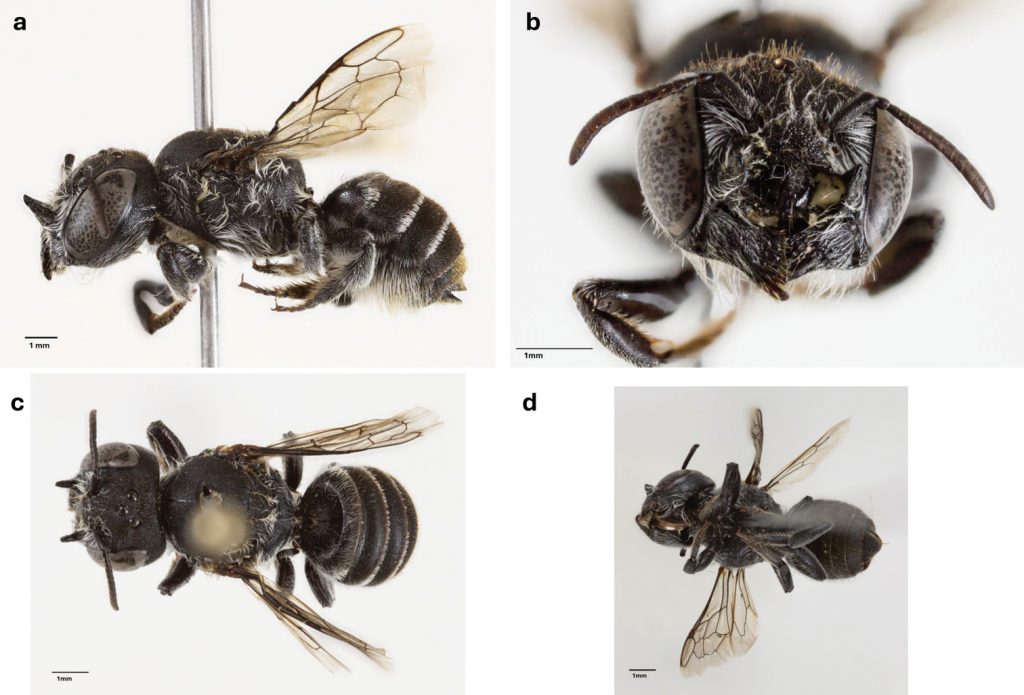Your cart is currently empty!
Lucifer Bee Unveiled: The New Species Lighting Up Biodiversity Research

In the heart of Western Australia, deep within a region that most people will never visit, scientists have uncovered a creature that sounds more like something from myth than biology. A newly identified leafcutter bee species, now named Megachile lucifer, has stunned researchers with its tiny, yet unmistakable, devil-like horns. While the discovery may sound playful or even spooky, it represents something far more important than a quirky headline. It is a reminder that even in a world mapped by satellites and surveyed by science, vast pockets of biodiversity remain unknown.
The Lucifer Bee, first collected during a 2019 survey and officially described in 2025, captured the world’s attention when scientists revealed that the females of the species carry miniature facial projections unlike anything previously documented in their group. As researchers studied the specimen in greater detail, the bee’s uniqueness became undeniable. Through careful comparison, genetic barcoding, and analysis across museum collections, scientists confirmed they were looking at a species entirely new to science.
This discovery has sparked curiosity not only because of the bee’s appearance, but because it highlights the fragile ecosystems that shelter life we have barely begun to understand. It invites us to look closer at the natural world, reconsider our environmental priorities, and reflect on how many species may vanish before we even know they exist. The story of the Lucifer Bee is more than a scientific milestone. It is a call to awareness, appreciation, and action.

What Is The Lucifer Bee?
The species officially named Megachile lucifer belongs to the leafcutter bee family, a group known for their solitary nature and their habit of cutting plant material to build nests. Unlike the familiar honeybee, leafcutter bees do not form colonies or hives. Instead, each female constructs her own nest, generally within small cavities, and lines it with carefully cut circular pieces of leaves. This method of nesting has made the Megachilidae family one of the most ecologically valuable groups of wild pollinators.
The Lucifer Bee’s most striking characteristic lies on its face. Female members of the species possess two small, curved protrusions pointing forward, giving them a horned appearance that is entirely unique in their subgenus. These horns are extremely small, measuring less than a millimetre, yet they are clearly visible under magnification and instantly distinguish the species from its known relatives. The males, interestingly, do not share this feature at all.
Researchers believe that the structure of these horns could serve a purpose, although the exact function remains unclear. Some scientists speculate that the horns could be used to interact with specific flowers, perhaps helping the bee access pollen or nectar in tight spaces. Others suggest they could play a defensive role during nest building or resource collection. Because so little is yet known about the species’ behaviour or ecological niche, these hypotheses remain open to future investigation.
The name Lucifer, chosen by the lead scientist, was inspired partly by the devilish appearance of the female bee and partly by the Latin meaning of the word, which translates to light-bringer. In a poetic sense, the name symbolizes the species’ role in illuminating how much biodiversity remains hidden in overlooked regions.
Where This New Species Was Discovered
The Lucifer Bee was found in the Bremer Range region of Western Australia, an isolated and strikingly biodiverse area located between the towns of Norseman and Hyden. This region is known for its rugged landscapes, pockets of rare vegetation, and unique ecological conditions that make it a hotspot for species found nowhere else on Earth. Because it is remote and difficult to access, much of its biodiversity has remained undocumented.
The bee was first collected in 2019 during a survey focusing on a rare plant species called Marianthus aquilonaris. This particular wildflower is critically endangered and known to grow only in very specific habitats within the Bremer Range. Scientists conducting the survey were examining potential pollinator relationships when they encountered the unusual bee. At first, there was no clear indication that it represented a new species, but its unusual face structure soon captured attention.

Over the following years, researchers revisited the region to gather additional samples. Despite multiple attempts, sightings of the Lucifer Bee remained rare, suggesting that the species may have a limited distribution. Whether the bee is naturally rare or simply difficult to detect remains unknown. Wild bees are often overlooked due to their solitary nature and their tendency to inhabit areas far from human activity.
Many parts of the Bremer Range face pressure from mining exploration and land use changes. Scientists have expressed concern that species like the Lucifer Bee could disappear before their ecological role is understood. The fact that this bee was found during a survey for another endangered species highlights how intertwined ecosystems can be and how easily one loss can ripple outward.
Why The Name Matters And What The Horns Could Mean
People around the world were immediately captivated when they heard of a bee named Lucifer. While the name may appear dramatic, it serves several important purposes within both scientific and public spheres. For researchers, the name reflects a genuine morphological characteristic that sets this species apart from its relatives. The distinctive horns offer a memorable visual cue that helps underscore its uniqueness.
The name also carries symbolic weight. In its Latin origin, Lucifer means light bearer, a fitting label for a species illuminating our understanding of hidden biodiversity. At a time when environmental awareness is growing yet many ecosystems remain overlooked, discoveries like this add a new spark to the conversation about conservation and scientific exploration.

As for the horns themselves, much remains to be discovered. Their presence suggests they may play a role in the bee’s daily activities. Some scientists believe they could help the bee manipulate particular flower structures, especially if the species has evolved alongside a specific plant. Others propose they could serve as a form of protection, giving females an advantage when competing for resources or defending nest entrances from predators.
Another possibility is that the horns may be used during nest construction. Leafcutter bees are known for their intricate nesting habits, and facial structures often assist in cutting or shaping plant material. Without direct observation, it is difficult to determine the exact purpose. Future studies will likely focus on behavioural research to determine how the horns function in the wild.
What This Discovery Means For Biodiversity
The uncovering of the Lucifer Bee highlights several key lessons about the state of biodiversity today. First, it demonstrates how much of the natural world remains undiscovered. Despite decades of scientific surveys, many insect species continue to hide in plain sight. Bees in particular are often under-studied, especially in remote regions. The discovery of the first new member of this subgenus in more than twenty years suggests that there may be entire branches of evolutionary history awaiting documentation.
Second, the find underscores how critical wild pollinators are to ecosystems. While honeybees receive most of the attention, thousands of lesser-known bee species play vital roles in pollinating wild plants. If these pollinators disappear, entire food webs can unravel. Because the Lucifer Bee was found during a study of a critically endangered flower, it presents an opportunity to explore whether this bee is a specialized pollinator for certain rare plants.
Third, the discovery emphasizes the fragility of ecosystems under pressure. Many parts of Western Australia are threatened by mining development, climate shifts, and habitat fragmentation. If areas like the Bremer Range are altered significantly, species such as the Lucifer Bee could be lost before scientists have the chance to study them. The fact that researchers located the bee while searching for another endangered species shows just how interconnected biodiversity truly is.
Finally, the discovery brings attention to the importance of environmental surveys. Many regions are approved for development without adequate ecological assessment, making it easy for rare species to vanish unnoticed. This case serves as a reminder that comprehensive surveys are essential to preserving the full breadth of life, especially in regions that have not been thoroughly studied.
What Comes Next For The Lucifer Bee
Researchers plan to continue studying the Lucifer Bee in order to uncover answers to several unanswered questions. Fieldwork will likely focus on determining its full habitat range, understanding nesting behaviour, and identifying its preferred floral resources. Only through sustained observation can scientists determine how the species fits into the larger ecological web of its region.
DNA analysis will continue to play a major role in future studies. By analyzing the genetic makeup of the Lucifer Bee and comparing it with related species, researchers may uncover clues about its evolutionary history. This information could shed light on how long the species has existed, how it diverged from its relatives, and whether it has any close yet undiscovered kin.

There is also growing interest in conducting environmental assessments in parts of the Bremer Range that face potential land use changes. Because so few specimens have been found, scientists are concerned that any major disturbance in the area could permanently eliminate the species. Conservationists are likely to advocate for protective measures or at least for more extensive biodiversity surveys before development proceeds.
Public engagement may play a larger role as well. The unusual appearance and memorable name of the Lucifer Bee have already helped draw global attention to native pollinators. By leveraging this momentum, environmental educators and conservation organizations can raise awareness about the importance of protecting wild insect species.
Illuminating Hidden Wonders
The discovery of the Lucifer Bee is a powerful reminder that countless secrets remain hidden in the natural world, even in regions we assume are well-explored. Each tiny detail, from its horn-like facial projections to its solitary nesting habits, invites curiosity and awe. By studying this species, scientists are not just cataloging another insect, but also uncovering insights about ecological interactions and the intricate web of life that sustains both common and rare species.
This unique bee also underscores the delicate balance of ecosystems. Its limited sightings suggest it may rely on very specific plants or habitats, making it highly sensitive to environmental changes. Protecting species like the Lucifer Bee requires a deep understanding of their surroundings, highlighting the importance of conserving habitats that may seem isolated or insignificant. Every small discovery reinforces the idea that preserving biodiversity is not optional but essential for the health of the planet.
Finally, the Lucifer Bee encourages public engagement and appreciation for the natural world. Its striking appearance and memorable name offer a bridge between scientific research and public interest. As awareness grows, there is greater opportunity to advocate for conservation measures, inspire citizen science, and spark curiosity in future generations of naturalists. This tiny creature, hidden in the remote Bremer Range, reminds us that even the smallest discoveries can illuminate the vastness of life still waiting to be understood.
Featured Image Credit: Kit S. Prendergast, Joshua W. Campbell
